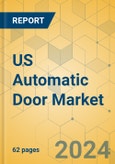Speak directly to the analyst to clarify any post sales queries you may have.
Security features such as advanced access control systems, biometric authentication, and surveillance integration significantly influence the market, especially in healthcare, transportation, and critical infrastructure sectors. The market is further driven by overall economic growth, leading to increased activities in commercial and residential facilities.
The expansion of the hotel and lodging industry, recovering from the pandemic's impact with rising occupancy rates, is expected to contribute to the market's growth. Additionally, heightened construction activities and home renovation trends fuel the demand for automatic doors. More than 28% of homeowners are undertaking home improvement and renovation projects, with door renovation being a key focus.
Another critical aspect of this market's growth is integrating smart building systems. As buildings become more intelligent and efficient, automatic doors equipped with IoT technology and sensors are increasingly incorporated into these systems. This integration enhances energy efficiency and operational control.
The presence of key players like ASSA ABLOY, dormakaba Group, STANLEY Access Technologies, and Boon Edam marks the competitive landscape of the US automatic door market. These companies focus on strategic collaborations, technological advancements, and market expansion to maintain and enhance their market positions.
In summary, the US automatic door market is experiencing dynamic growth, driven by technological innovations, economic factors, and changing consumer preferences, with significant growth opportunities in both the commercial and residential sectors.
KEY HIGHLIGHTS:
- In the US, the demand for automatic doors is driven by overall economic growth in the country. In the US, the expected economic growth during the forecast period is expected to spur commercial and residential facilities activities, which, in turn, will drive the requirement for amenities such as automatic doors.
- These expanding hotel and lodging facilities are expected to drive the country's automatic door market. In the US, the hotel industry has experienced growth in 2023, building upon the momentum gained in 2022. Rising occupancy rates drive the recovery.
- Economic growth may also result in increased construction activities, an increase in the number of business establishments, and the construction of commercial or industrial buildings, which will generate a high demand for automatic door systems. Thus, improved economic conditions will support higher product sales during the forecast period.
- This rising demand for commercial infrastructure is high in the US and worldwide, with growing investments by various companies and banks. The investment in commercial spaces such as shopping malls, retail spaces, and offices is expected to support the market for automatic doors during the forecast period.
- Rental housing is also increasing in the US, creating home remodeling and renovation opportunities. It has been observed that in recent years, most homeowners tend to renovate their houses instead of moving into new ones. More than 28% of homeowners undertaking home improvement and renovation projects. Door renovation is one of the important improvements in their homes. This can further drive the demand for automatic doors in the country.
- Infrastructural investments in commercial places such as hospitals, hotels, retail stores, and malls, among others, are also creating opportunities for the automatic doors market in the region. For instance, security is becoming one of the important trends in commercial spaces, which involves maintaining security by installing high-quality doors. Thus, these factors support the market for automatic doors in commercial spaces.
THE FOLLOWING MARKET SEGMENT ANALYSIS IS INCLUDED IN THIS REPORT
SEGMENTATION & FORECAST
Type (Revenue)
- Sliding Door
- Swinging Door
- Revolving Door
- Folding Door
Technology (Revenue)
- Infrared Sensor
- Microwave Sensor
- Others
End-User (Revenue)
- Residential
- Commercial
- Industrial
- MARKET STRUCTURE
- Market Dynamics
- Competitive Landscape of the US Automatic Door Market
- Key Vendors
- Other Prominent Vendors
- APPENDIX
- Research Methodology
- Abbreviations
- About the Analyst
Key Vendors
- ASSA ABLOY
- Boon Edam
- dormakaba Group
- Nabtesco Corporation
- STANLEY Access Technologies
Other Prominent Vendors
- Automatic Door and Hardware
- CAME
- Deutschtec
- FAAC
- Hörmann
- Horton Automatics
- KONE
- Manusa
- QUIKO
- TORMAX
KEY QUESTIONS ANSWERED:
1. What is the projected value of the U.S. automatic door market by 2029?2. What factors are driving the growth of the U.S. automatic door market?
3. What trends are observed in the residential sector regarding automatic doors?
4. How are smart building systems influencing the automatic door market?
Table of Contents
Companies Mentioned
- ASSA ABLOY
- Boon Edam
- dormakaba Group
- Nabtesco Corporation
- STANLEY Access Technologies
- Automatic Door and Hardware
- CAME
- Deutschtec
- FAAC
- Hörmann
- Horton Automatics
- KONE
- Manusa
- QUIKO
- TORMAX
Methodology
Our research comprises a mix of primary and secondary research. The secondary research sources that are typically referred to include, but are not limited to, company websites, annual reports, financial reports, company pipeline charts, broker reports, investor presentations and SEC filings, journals and conferences, internal proprietary databases, news articles, press releases, and webcasts specific to the companies operating in any given market.
Primary research involves email interactions with the industry participants across major geographies. The participants who typically take part in such a process include, but are not limited to, CEOs, VPs, business development managers, market intelligence managers, and national sales managers. We primarily rely on internal research work and internal databases that we have populated over the years. We cross-verify our secondary research findings with the primary respondents participating in the study.

LOADING...
Table Information
| Report Attribute | Details |
|---|---|
| No. of Pages | 62 |
| Published | February 2024 |
| Forecast Period | 2023 - 2029 |
| Estimated Market Value ( USD | $ 5.05 Billion |
| Forecasted Market Value ( USD | $ 6.48 Billion |
| Compound Annual Growth Rate | 4.2% |
| Regions Covered | United States |
| No. of Companies Mentioned | 15 |









